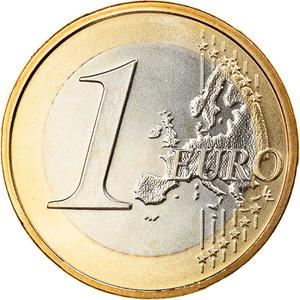The One Euro coin (€1.00) is a circulating bi-metallic coin made of two alloys: the inner part of cupronickel, and the outer part of nickel brass. Like all other common circulation coins (from 1 cent to €2), the denomination is issued by the separate countries in the Eurozone and is legal tender in all of them, irrespective of which country has issued it. The denomination was introduced in 2002, when Germany retired the German Mark currency and introduced the Euro.
The coins have a common reverse designed by Luc Luycx in 1999 which shows a map of the European Union; it was changed in 2007 to reflect the enlargement of the Union. Each country has its own national obverse; the German obverse was designed by the family duo of designers Heinz Hoyer and Sneschana Russewa-Hoyer; it features an interpretation of the German Federal Eagle - the Bundesadler (German for "Federal Eagle"), formerly known as Reichsadler (German for "Imperial Eagle") - a symbol of German sovereignty.
Germany has five mints striking circulation coins, which have an arrangement whereby each mint strikes a specific proportion of the circulation coins every year. The mints and their mint marks are:
- Berlin Mint - mint mark A
- Munich Mint - mint mark D
- SMBW - Stuttgart (ex Stuttgart Mint) - mint mark F
- SMBW - Karlsruhe (ex Karlsruhe Mint) - mint mark G
- Hamburg Mint - mint mark J
Note that two of them are part of Staatliche Münzen Baden-Württemberg (SMBW) - the State Mints of Baden-Württemberg - after they merged in 1998, but operate separate facilities and use different mint marks. | 



